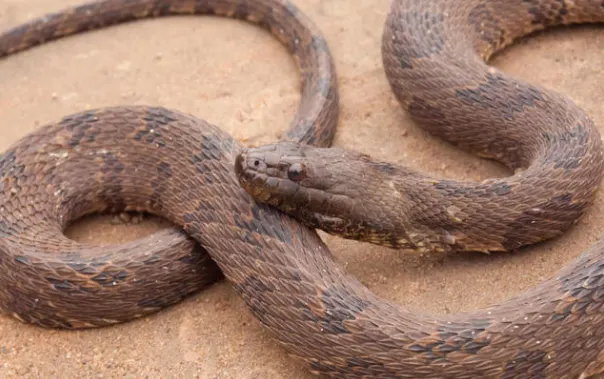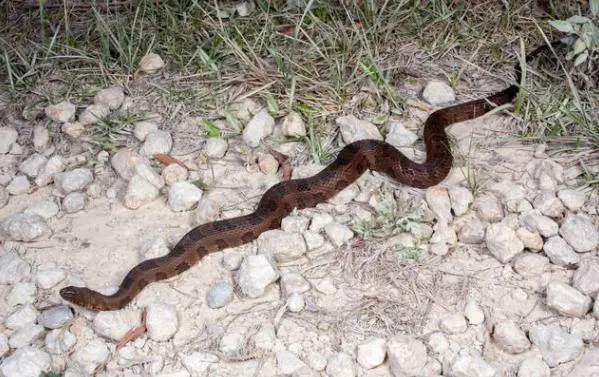The Brown Water Snake, known scientifically as Nerodia taxispilota, is a fascinating and often misunderstood species native to the southeastern United States. Despite its fierce appearance and a reputation that often leads to confusion with more dangerous species, the Brown Water Snake is a nonvenomous, skilled hunter that plays a vital role in its aquatic ecosystem.

Table of Contents
Appearance and Physical Characteristics
The Brown Water Snake is easily recognizable by its thick, heavy body and distinct coloration. It sports a light brown base color with darker brown rectangular patches along its back, giving it a somewhat checkered appearance. These patches are typically larger on the back than on the sides, and they do not connect, which is a helpful identification feature.
One of the most striking physical features of this snake is its broad, triangular head, which can cause it to be mistaken for the venomous Cottonmouth. However, unlike the Cottonmouth, the Brown Water Snake lacks the heat-sensing pits found between the eyes and nostrils of venomous pit vipers. Another distinguishing characteristic is its keeled scales, which are rough to the touch and provide the snake with added grip in its watery habitat. This snake also has more dorsal scale rows than any other water snake on the continent, with 27 to 33 rows along its back.
Habitat and Range
Brown Water Snakes are highly aquatic and are typically found in slow-moving bodies of water such as rivers, swamps, and creeks throughout the southeastern United States. Their range includes states like Florida, Georgia, Alabama, and the Carolinas. These snakes are excellent swimmers and are often seen basking on branches overhanging water, where they can quickly drop into the water to escape predators.
Diet and Hunting Behavior
The Brown Water Snake’s diet primarily consists of fish, with a particular preference for catfish. Despite the sharp spines of catfish, which can sometimes puncture the snake’s skin, the Brown Water Snake has adapted to handle this dangerous prey. Remarkably, they often survive these injuries and continue to thrive in their habitats. The snake hunts primarily by scent, rather than sight, allowing it to detect prey even in murky waters.
Fun Facts About Brown Water Snakes
- Daredevil Diet: These snakes take on the risky task of hunting catfish, whose sharp spines can puncture the snake’s body after being swallowed. However, the resilient Brown Water Snake usually survives and recovers from these injuries.
- Falling Act: When startled, Brown Water Snakes have been known to drop from tree branches straight into the water, making a quick and dramatic escape.
- Nonvenomous but Feisty: Although they are nonvenomous, Brown Water Snakes will not hesitate to defend themselves if threatened. They may hiss, coil, and strike, and even release a foul-smelling musk as a deterrent.
Conservation Status
The Brown Water Snake is classified as “Least Concern” on the conservation scale, meaning it is not currently at risk of extinction. However, they do face threats from habitat loss and human persecution. Unfortunately, due to their resemblance to the venomous Cottonmouth, many Brown Water Snakes are killed out of fear or misunderstanding.

Brown Water Snake vs. Cottonmouth
One of the most significant challenges for the Brown Water Snake is its similarity in appearance to the venomous Cottonmouth, also known as the Water Moccasin. Both species have a similar body shape and coloration, and both inhabit similar environments. However, there are several key differences:
- Head Shape: While both have triangular heads, the Cottonmouth’s head is broader, and its neck is less distinct.
- Mouth Color: Cottonmouths have a bright white interior lining in their mouths, visible when they feel threatened and open wide in a defensive posture. In contrast, the Brown Water Snake’s mouth is dark-colored.
- Eye Pits: Cottonmouths, being pit vipers, have distinctive heat-sensing pits between their eyes and nostrils. These pits are absent in the Brown Water Snake.
The Brown Water Snake is an impressive species that plays a crucial role in its ecosystem, particularly in controlling fish populations. Understanding and appreciating the Brown Water Snake’s role in nature can help reduce unnecessary harm to these nonvenomous creatures and ensure they continue to thrive in their natural habitats. So next time you see a Brown Water Snake, remember: it’s not out to get you, and it’s more interested in catching its next meal than in causing harm!
- Enchi Ball Python: A Unique and Stunning Morph of Python regius - March 27, 2025
- Emerald Tree Monitor: The Enigmatic Green Guardian of the Rainforest - March 26, 2025
- The Egyptian Cobra (Naja haje): A Fascinating Serpent - March 25, 2025
